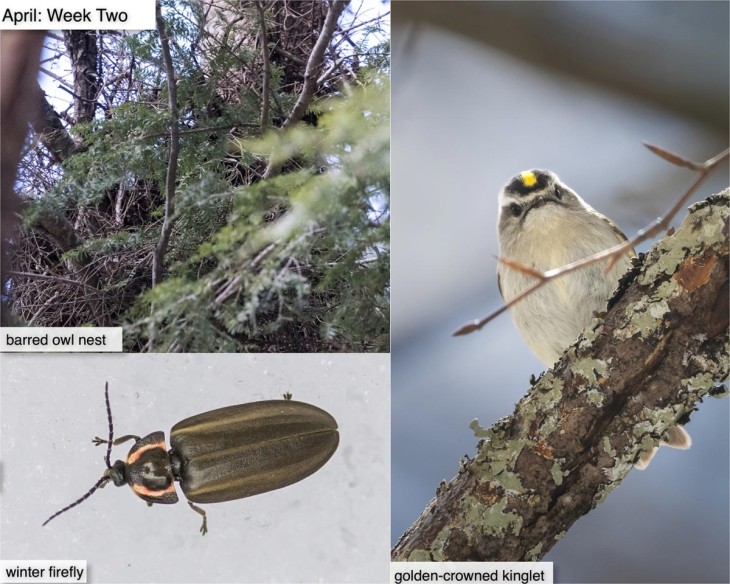This week in the woods, one of our most exciting finds was, by design, not very exciting to look at. This is a well-hidden active barred owl nest, a status we realized a few seconds after taking this photo, when a barred owl flew out of it, and its mate began hooting at us. We retreated quickly, and although we may make some long-distance photo attempts across a valley, will maintain a respectful distance to avoid stressing the birds.
Barred owls most frequently nest in tree cavities, but they will also re-use platform nests that other large birds – or even squirrels – constructed. Improvements to these old nests are modest; we’ve previously seen barred owls add hemlock stems to nests, but there doesn’t appear to be anything new added here. It’s likely the owls laid their eggs in late March and are brooding now. This Outside Story article by Anna Morris describes owl nesting behavior.
Golden-crowned kinglets live in northern forests all year round. They shouldn’t be building nests for another month or so. That said, on multiple days this past week, we’ve encountered a pair of kinglets chasing each other around at the edge of a vernal pool, so perhaps they’re making plans. As noted in their species profile in the Cornell Lab of Ornithology’s Birds of the World profile, these tiny birds often suspend their cup shaped nests in the forked twigs of conifers. Here’s a fun Outside Story article by Kenrick Vezina, describing golden-crowned kinglets’ remarkable winter hardiness.
We’re a long way from warm summer nights, but you can still find Photinus corrusca, the winter firefly, crawling around on tree trunks and snow, and all too frequently falling into sap buckets. As Declan McCabe notes in this Invertebrate Bestiary column from the Winter 2023 issue of Northern Woodlands magazine, the species uses pheromones instead of flashy displays to attract mates. According to McCabe, “The ability to find each other in daylight allows them to mate in early spring, when nighttime temperatures are still too cold for insect muscles.”
Finally, although we’ll spare you our blurry photos, we observed a pair of red-shouldered hawks circling and calling to each other and one hawk (presumably the male) performing a “sky dance,” in which he made repeated, dramatic dives. These are courtship displays. Look for them this week, above a forest near you.
What have you noticed in the woods this week? Submit a recent photo for possible inclusion in our monthly online Reader Photo Gallery.


